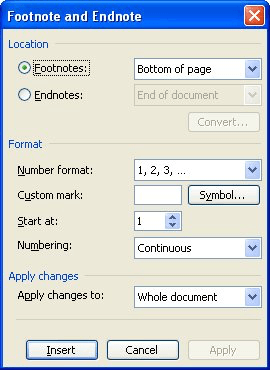Please Note: This article is written for users of the following Microsoft Word versions: 97, 2000, 2002, and 2003. If you are using a later version (Word 2007 or later), this tip may not work for you. For a version of this tip written specifically for later versions of Word, click here: Inserting Footnotes Using Custom Footnote Marks.
Written by Allen Wyatt (last updated September 4, 2019)
This tip applies to Word 97, 2000, 2002, and 2003
Footnotes are used to provide printed annotations or references for a document. Word makes it very easy to insert automatic footnotes in your documents. What if you want to insert a custom footnote, however? Fortunately it is just as easy:
The steps are slightly different if you are using Word 2003:

Figure 1. The Footnote and Endnote dialog box
WordTips is your source for cost-effective Microsoft Word training. (Microsoft Word is the most popular word processing software in the world.) This tip (541) applies to Microsoft Word 97, 2000, 2002, and 2003. You can find a version of this tip for the ribbon interface of Word (Word 2007 and later) here: Inserting Footnotes Using Custom Footnote Marks.

Do More in Less Time! An easy-to-understand guide to the more advanced features available in the Microsoft 365 version of Word. Enhance the quality of your documents and boost productivity in any field with this in-depth resource. Complete your Word-related tasks more efficiently as you unlock lesser-known tools and learn to quickly access the features you need. Check out Microsoft 365 Word For Professionals For Dummies today!
Footnotes appear at the bottom (or foot) of each page. It is an easy task to insert a footnote at any point you desire, ...
Discover MoreWith lots of endnotes in a document, you may be puzzled by the space left between the endnote numbers and the text that ...
Discover MoreIf you need to move footnotes or endnotes from one location to another in a document, you can use editing techniques you ...
Discover MoreFREE SERVICE: Get tips like this every week in WordTips, a free productivity newsletter. Enter your address and click "Subscribe."
There are currently no comments for this tip. (Be the first to leave your comment—just use the simple form above!)
Got a version of Word that uses the menu interface (Word 97, Word 2000, Word 2002, or Word 2003)? This site is for you! If you use a later version of Word, visit our WordTips site focusing on the ribbon interface.
Visit the WordTips channel on YouTube
FREE SERVICE: Get tips like this every week in WordTips, a free productivity newsletter. Enter your address and click "Subscribe."
Copyright © 2025 Sharon Parq Associates, Inc.
Comments